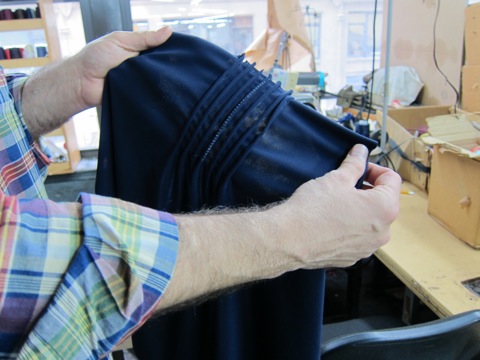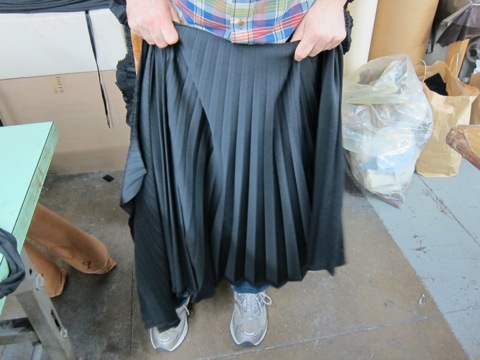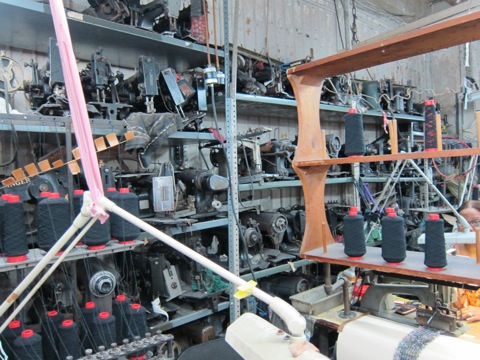Rodger Cohen
Stitching Stories: Rodger Cohen
By Jessica Gold
Inspired by the glamorous gowns displayed this past Spring at the Madame Gres exhibit at the Musée Bourdelle in Paris, and by the effortless minimalism of Yohji Yamamoto’s 1990s designs, pleating has returned as a major fashion trend. A pleat is a design technique in which fabric is doubled upon itself and then pressed or stitched into place. Fortuny-like silk pleated dresses, plaid wool kilts and pin-tucked blouses are all hitting stores, thanks in large part to the guidance and detailed work of pleaters and stitchers.
In New York City, home of the Garment District and birthplace of the apparel industry in the United States, pleating, stitching and embroidery have long been integral to the work of America’s most famous fashion designers. In the post-war era, when millions of immigrants arrived to New York from Europe, in need of work and opportunity, many turned to apparel manufacturing. Often, these entrepreneurs brought skills, techniques and business acumen acquired by owning or working for similar manufacturing operations in Europe. With this influx of motivated manufacturers and skilled laborers, the garment industry burgeoned quickly; by the 1930s, New York City’s apparel manufacturing business was the largest in the world. Among those thousands of cut and sew businesses were hundreds of pleating, stitching and embroidering shops. These businesses were unionized under the Pleaters, Stitchers, and Embroiders Association, which is now under the governance of Unite Now. Today, the Association counts only 55 employees as members.
The dramatic decline in the number of pleating and stitching business in New York has paralleled the general downturn in apparel manufacturing in the United States. Beginning in the 1970s, and increasing over the following decades, fashion business owners outsourced work to factories in China, Vietnam, Indonesia and Central America. The initial attraction was capitalistic: apparel business owners were attracted to the lower labor costs and higher profits in producing overseas. Unfortunately, this shift led to a hugely diminished number of domestic manufacturing businesses. Recently, there’s been a groundswell of interest in American-made goods and support for the Garment Center and industry. The costs of manufacturing abroad are rising and leading high-end and mid-priced designers and businesspeople to rethink their manufacturing strategies. The benefits of producing locally are many: control, quick turnaround time and low to no shipping costs. The future remains to be seen.
Regal Originals
One of the pleating and stitching businesses still standing in New York City is Regal Originals. Located on 37th Street, in the Garment District, the business is presided over by Rodger Cohen and his daughter, Dalia Sabari. Today, Regal Originals is the go-to pleating and stitching source for almost every American couture, bridge, contemporary, and mass-market apparel business. Cohen and Sabari list clients such as Anna Sui, Calvin Klein, Carolina Herrera, Catherine Malandrino, Diane von Furstenberg, Jason Wu, Marchesa, Marc Jacobs, Nanette Lepore, Oscar de la Renta, Nicole Miller, Yeohlee and Yigal Azrouel, among many others. Regal Originals’ services include crystal, Fortuny, knife, mushroom, sunburst, pineapple and machine pleating, applique stitching, elastic and thread shirring and smocking, faggoting, hand flowers, hemstitching, pearl and picot edging, pin tucking, saddle stitching, and zig zag hemming.
At first glance, Regal Originals is a gritty, slightly dark and loud environment, but upon closer inspection, the kind of work that’s being done is incomparably beautiful. Much of the pleating is done by hand, and the results are breathtaking. Several of Regal Originals’ employees have been at the company for more than 50 years, and it’s evident that there is a loyal team mentality at the factory.
Mr. Cohen is the son-in-law of Regal Originals’ founder, Jack Krinick, who opened the business in 1950. Mr. Cohen shared the story of how Mr. Krinick got his start.
“My father-in-law came to New York City after surviving the Holocaust in Poland. His whole family was wiped out and he came here with just his father. They were the only two from their entire town who survived.”
The Garment Center afforded him the ability to get a job right away. He was unskilled at that time and he didn’t have any education. As a child, he’d run a step ahead of Hitler. The Garment Center gave him the chance to start working. In his blood, he had business mentality and philosophy. His father had been a wealthy businessman in Poland.
Although he first worked as a sewing machine operator, he knew that it wasn’t the career for him. He knew that he had to be his own boss. He slowly acquired machines and then began to hire employees. By the 1950s, he had built a small company. By the 1970s, it grew to more than 250 people. “On 27th St., where the business was first located, my father-in-law had five floors in a building;”, Mr. Cohen explained. “He was killing himself running up and down between them. This building that we currently work from came up for sale in 1979 when the whole city was in bankruptcy. So my father-in-law took all his money, and with some partners, he bought this building and became a tenant in it. He then began to expand and grow his business.”
Rodger Cohen’s Career
Mr. Cohen went on to say that, as a young man, he became involved in the Regal Originals business, and eventually took over the company when his father-in-law retired: “This has always been a family business. I started to work here in 1980, and at that point, my father-in-law was ready to slowly retire. Long weekends in Florida became winters in Florida.
My father-in-law had three kids: two sons and a daughter. He told his older son to become a doctor. He told his younger son to become a dentist, and he told his daughter, in typical European male chauvinist style, to find a husband that could run his business. I joked with her that it was entrapment! But it just worked out. My wife and I were high school sweet hearts; she lived just a few blocks from me in Brooklyn. When I finished high school, and was headed to college, my future father-in-law knew that I was looking for a part-time job and told me to come work for him. And that’s when the entrapment started! But honestly, he really handed me the business on a silver platter. He taught me everything.“
Mr. Cohen is an original member of Save the Garment Center and a general supporter of preserving apparel manufacturing in New York City and in the U.S. He described the gradual transference from domestic to international manufacturing and how those changes affected Regal Originals.
The Decline of the Pleating Business
“In the late 1980s, things started to change with imports, but there was still so much work being done domestically that it didn’t hugely affect the manufacturing business here in New York City. But in the 1990s, the slow period began to get slower, the busy period started to get less busy, and things started to get a little scary. And then, it just started to continue in that direction. By 2000, things had changed fairly drastically.
The pleating and stitching business is a tough business. In the 1980s, there had been 400 pleating and stitching shops and an association that had a calendar that came out every year listing all of them. Now, I believe we are the last shop left that’s still unionized. There’s one other shop, but he basically specializes in theatrical costumes. Everyone in the business comes to us for their pleating and stitching needs, but even with that, the volume is not enough. We make our living on programs - huge orders from places like J.C. Penney that need constant replenishment. We’re left to do production for the better companies and we have some programs for about 40,000 to 50,000 pieces.”
Besides the pleating and stitching business, Mr. Cohen has established his own entrepreneurial design and manufacturing businesses. Doing so has allowed him to pursue his own goals and to keep Regal Originals in business.
“In the late 80s, the pleating and stitching business was starting to slow down. That’s when I started to do my own line of manufacturing. I did that for twenty some-odd years and it was very successful. The company was called Drama or Dramatic Expressions. About three years ago, when the economy turned south, everything fell apart. I was pretty down, and my daughter Dalia encouraged me to start all over again. She quit her job and we started a nursing uniform company. We’ve been doing that for just about a year now, and the name of the company is Scrub Ink. We produce a unique line of scrubs made in New York City. We give the nurse the ability to personalize her own uniform. We sell via e-commerce and have some corporate accounts including high-end nursing facilities and physical therapy centers. We also currently represent many uniform lines.”
The Garment District: Past, Present and Future
Having been in the business for over 30 years, Mr. Cohen recalled a lively, raucous Garment District of bygone times.
“I remember years ago, early on Thursday mornings, when the trucks and huge tractor- trailers in the Garment Center used to line up to get the right parking spots. There would be fights on the street. They wanted to be close to the buildings that they were unloading freight to each day. Now, you can pull a tractor-trailer up at 2 o’clock in the afternoon and park anywhere you want. UPS used to have two 18-wheelers, and now they only have one small truck working in the Garment District.”
When asked about his vision of the future of the Garment District and of domestic manufacturing, Mr. Cohen’s attitude was hopeful, but realistic.
“I think a lot of companies have become a bit fed up with overseas manufacturing. They’re frustrated with price increases, labor increases and material increases.
I’ve been on the original committee for Save the Garment Center and I came up with a plan of initiatives that would mandate stores to display, not only on labels, but on racks, that garments are made in Vietnam or Pakistan or China. No one knows and no one cares, but they should. There should be a grassroots campaign for people who want to buy American-made goods. If some of the larger American designers started to make even 5% of their lines in America, would they really lose any profits? No. If they did, the stores could highlight the goods made in America.
I don’t know what will survive or if the business can come back. It’s very tough. I’m concerned that when the countries that we outsource production to become innovators, instead of copiers, we’re in real trouble. We at Regal Originals show designers here that they can make garments here in New York City for the same or only a little bit more than overseas. The advantage they have in doing that is they don’t have to plan six months in advance. They don’t have to anticipate 5000 pieces. They can tell a store to order 1200 pieces, and see how they sell, and then we can do a quick re-order in three weeks. You can’t do that overseas. We’ve showed certain companies this, and we’re reaping the benefit of that now.”
As a family business, Regal Originals is poised to stand their ground and to move into the future. They’re a stalwart of the Garment District and of the apparel business in America. With great experience and the relationships they’ve developed over so many years, it seems that they will continue to be a top resource and manufacturer in New York City.
Mr. Cohen finished by saying, “this business is about relationships. I work with young designers now with very small minimums, who ask me to work with them, even though they can’t pay me up front. I know that their orders can go from 12 pieces to 50 pieces to more than that each season. You could never accomplish that type of rapport overseas. I’ve had designers come in here with tears who have started with a factory abroad, and been burned by late deliveries and lack of communication. I help them out immediately. Again, to me, it’s all about relationships.”






